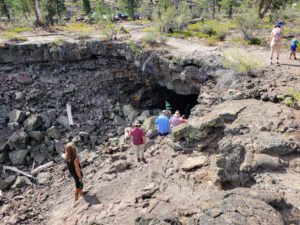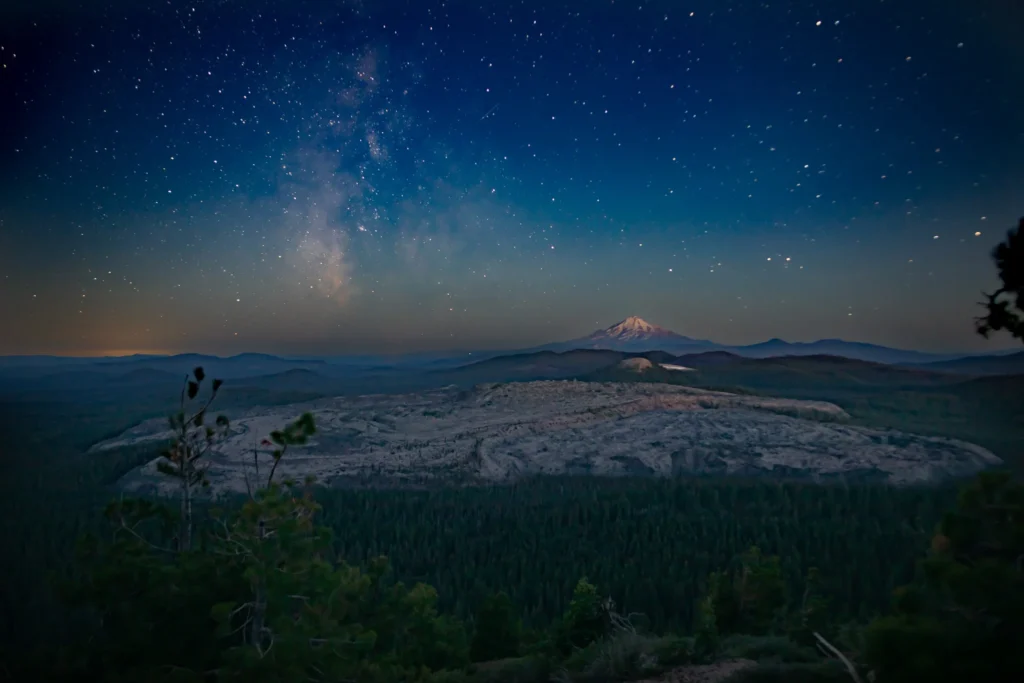The newly designated Sáttítla Highland National Monument(Opens in a new window) (SHNM) is a landscape that feels almost otherworldly. Shaped by fire and carved by ice, this high volcanic plateau is dotted with sapphire lakes, ancient forests, and jagged lava flows. At its center lies Medicine Lake, a shimmering jewel nestled in the caldera of the Medicine Lake Volcano—the largest volcano in the Cascade Range, nearly ten times the size of Mount St. Helens.
Visitors are drawn here year-round to experience a wildness that’s rare in our time. In summer, the monument offers hundreds of miles of trails for hiking and backpacking, quiet forest roads for biking, and alpine lakes perfect for paddling or fishing. Campers spread out beneath towering pines, and at night the skies come alive with stars—the area is recognized as one of the darkest and quietest places in California. In winter, the highlands transform into a vast snow-covered sanctuary, where only the most prepared adventurers venture in on skis or snowshoes to find solitude and silence.

Part of what makes exploring Sáttítla so captivating is its exceptional biodiversity. More than 450 native plant species grow here, from wildflower meadows that erupt in color each summer to the ancient whitebark pine, a high-elevation species now considered endangered. Wildlife enthusiasts may glimpse the threatened northern spotted owl, or track the movements of elusive forest dwellers like the Pacific fisher and American marten. Birders, botanists, and casual hikers alike find themselves immersed in a living classroom—every step on the trail reveals rare plants, unique volcanic geology, or the call of a bird found nowhere else.
Beyond recreation and ecology, Sáttítla is a place of profound meaning. For at least 10,000 years, it has been sacred to the Pit River and Modoc Nations, as well as other Tribes across the region. Here, ceremony, prayer, and cultural teachings continue to this day. The waters of Sáttítla are revered not only as sacred but also as life-giving: beneath the monument lies one of the largest natural aquifers in North America, holding as much water as 200 of California’s biggest reservoirs combined. These waters flow outward, nourishing rivers, farmland, and fisheries that sustain millions of people. “The landscape of the area literally tells the history of our people. In that way, it is part of the true history of the United States of America,” said Brandy McDaniels, a Pit River Nation member and Sáttîtla Highlands National Monument lead for the Tribe.

But this unique landscape has also been contested ground. In the 1980s, geothermal companies sought to industrialize the volcanic highlands. Power plants, roads, and drilling pads would have scarred the land and risked polluting its aquifers. The Pit River Tribe(Opens in a new window) and the Mount Shasta Bioregional Ecology Center(Opens in a new window)(MSBEC) fought back in court for more than two decades, ultimately winning a decisive victory in 2019 when the Ninth Circuit Court of Appeals canceled long-term geothermal leases. Still, the threat persisted.
In 2023, the Tribe and its allies launched a campaign for permanent protection through the Antiquities Act. Support came from all corners: scientists, recreationists, Tribal leaders nationwide, and more than 140 businesses and organizations. Letters poured in highlighting the monument’s scientific, cultural, and recreational value. In December 2024, more than 500 community members packed a USDA listening session in Weed, CA—90% voicing support for monument status. One month later, on January 14, 2025, President Biden stood with Tribal leaders and community advocates to sign the proclamation establishing Sáttítla Highland National Monument.
The designation was a victory decades in the making—but the story doesn’t end there. National monuments are now once again under political attack, with proposals to shrink or even eliminate them. If those efforts move forward, Sáttítla could be on the chopping block, and the Pit River Tribe, MSBEC, and allies will once again need public support to defend it.

You can help keep Sáttítla protected:
-
Stay connected through MSBEC’s newsletter(Opens in a new window).
-
Follow and share updates on social media @MtShastaEco(Opens in a new window).
-
Donate to support community and legal defense.
Sáttítla is more than a monument. It is a living sanctuary of fire and water, a place of deep cultural reverence, and a haven for hikers, skiers, stargazers, and families seeking wild beauty. Support from organizations like The Conservation Alliance(Opens in a new window) has enabled the Mount Shasta Bioregional Ecology Center to remain focused on protecting the landscape and aquifer that so many people cherish and depend on. By mobilizing more than 140 outdoor companies and communities across North America, TCA(Opens in a new window) helps us ensure that places like Sáttítla remain protected not just today, but for generations.
Title Image: Brilliance of the Night Skies, Photo Credit: Bob Wick



